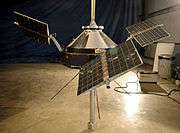Explorer 12
| Mission type | Space Physics |
|---|---|
| Operator | NASA |
| COSPAR ID | 1961-020A |
| SATCAT no. | 170 |
| Website | |
| Mission duration | ~4 months |
| Spacecraft properties | |
| Manufacturer | GSFC |
| Launch mass | 37.6 kilograms (83 lb) |
| Dry mass | 37.6 kilograms (83 lb) |
| Power | Solar |
| Start of mission | |
| Launch date | 16 August 1961, 23:21 UTC |
| Rocket | Thor-Delta |
| Launch site | Cape Canaveral LC-17B |
| End of mission | |
| Last contact | 6 December 1961 |
| Decay date | 1 September 1963 |
| Orbital parameters | |
| Reference system | Geocentric |
| Regime | LEO |
| Eccentricity | 0.84091 |
| Perigee | 790 kilometers (490 mi) |
| Apogee | 77,620 kilometers (48,230 mi) |
| Inclination | 33.4° |
| Period | 1587 minutes |
Explorer 12 (also known as S3) was a United States Satellite built to measure Solar wind, Cosmic ray, and Magnetic field[1]. It was launched on August 16 1961, aboard a Thor-Delta booster[2]. Explorer 11 was the first of the 3 S3 series spacecraft. It ceased transmitting on December 6 due to power failure.
Instruments

Explorer 12
Explorer 12 was designed to study space physics, and so had a multitude of instruments including a cosmic-ray detector, a particle trapper, and a magnetometer. Good data was recorded for 90% of the mission.
References
- ↑ Explorer 12 Description nasa.gov
- ↑ Explorer 12 orbit nasa.gov
This article is issued from
Wikipedia.
The text is licensed under Creative Commons - Attribution - Sharealike.
Additional terms may apply for the media files.
.png)